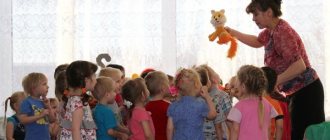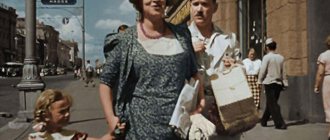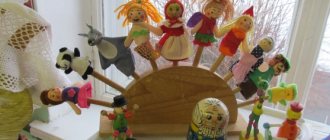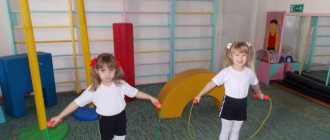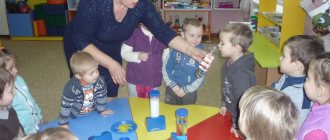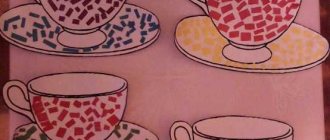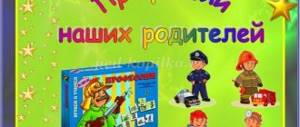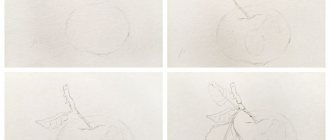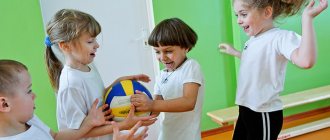Card index of outdoor games “The gray bunny is washing his face. The ball goes through the net. By the bear in the forest"
Anna Petrushenkova
Card index of outdoor games “The gray bunny is washing his face. The ball goes through the net. By the bear in the forest"
CARD INDEX OF OUTDOOR GAMES
Middle group
(according to the program “From birth to school”, edited by N. E. Veraksa)
«The gray bunny is washing his face...»
(jumping)
Objectives: Practice jumping on two legs while moving forward. Learn to correlate actions with words.
Material: Bunny .
Progress of the game: Everyone stands in a circle, a bunny , he stands in the center of the circle. Children forming a circle say:
The gray bunny is washing his face . Washed my tail
Apparently he's going to visit, he washed his ear,
I washed my nose and wiped it dry!
The bunny makes all the movements corresponding to the text. Then he hops on two legs, moving forward (to visit)
to someone standing in the circle.
He takes the place of the bunny .
"Ball over the net "
(throwing and catching the ball)
Objectives: Teach children to compete. Practice throwing the ball over the net with both hands from below and from behind your head.
Material: Balls and net .
Progress of the game: At a distance of 1 m from the net , on a line on both sides, groups of children stand opposite each other. At the teacher’s signal: “Start!”
— the child throws the ball
over the net to the child standing opposite.
Having caught the ball, he throws it to the person standing next to him, etc. When the ball reaches the last player, the teacher notes what mistakes were made by the groups of players. "Find where it's hidden"
(orientation in space)
Objectives: Learn to navigate a room or area, perform actions on a signal.
Material: Any item that can be hidden.
How to play: Children stand along the wall. The teacher shows them the object and says that he will hide it. The teacher invites the children to turn to the wall. After making sure that none of the children is looking, he hides the object, and then says: “It’s time!”
. Children begin to look for the object.
"By the bear in the forest "
(Run)
Objectives: To teach children to alternately perform different functions (run away and catch)
.
Material: Mushrooms, berries, baskets, bear .
Progress of the game: The bear's (at the end of the site)
and the children's house on the other. Children go for a walk in the forest and perform movements according to the verse, which they recite in chorus:
At the bear in the forest ,
I take mushrooms and berries,
But the bear doesn't sleep
And he growls at us.
As soon as the children finished saying the poem, the bear gets up with a growl and catches the children, they run home.
"Find and keep silent"
(orientation in space)
Objectives: Learn to navigate in the hall. Cultivate endurance and ingenuity.
Material: Any item that can be hidden.
Progress of the game: The teacher shows the object to the children, and after they have closed their eyes, he hides it. Then he offers to look, but not to take it, but to tell him in his ear where it is hidden. Whoever finds it first is the leader in the next game
"AIRCRAFT"
(run)
Objectives: To develop spatial orientation in children, to strengthen the skill of building in a column. Practice running.
Description: Children line up in 3-4 columns in different places on the site, which are marked with flags. The players portray pilots on airplanes. They are preparing to fly. At the teacher’s signal “Get ready for flight!”
“The children are circling with their arms bent at the elbows,”
says the teacher. Children raise their arms to the sides and fly scattered in different directions. At the teacher’s signal “Landing!”
— the planes find their seats and land, form columns and drop to one knee. The teacher notes which column was built first.
Rules:
The players must take off after the teacher’s signal “Fly!”
.
At the teacher’s signal “Landing!”
- the players must return to their columns, to the places where their sign is posted
(checked)
.
Options: While the planes are flying, swap the flags and take them to the opposite side. Change leaders in columns.
"COLORED CARS"
(run)
Objectives: To develop children's attention, the ability to distinguish colors and act on a visual signal. Exercise children in running and walking.
Description: Children are sitting along the wall, they are cars. Each person is given a flag of some color. The teacher stands facing the players, in the center. In your hand there are 3 colored flags, according to the colors of the traffic light. Raises the flag, children with a flag of this color run around the playground in any direction, honking their horn as they go, imitating a car. When the teacher lowers the flag, the children stop, and at the signal “The cars are coming back!”
— they walk towards their garage. Then the teacher raises a flag of a different color, but can raise 2 or all 3 flags together, then all the cars leave the garage.
Rules:
You can leave the garages only with a signal from the teacher, and return to the garage also with a signal.
If the flag is omitted, the cars do not move.
Options: Place landmarks of different colors in the corners. At the signal “Cars are leaving”
, at this time swap the landmarks. Invite children to remember different brands of cars.
"FOX IN THE CHICKEN COOP"
(jumping)
Objectives: To develop in children dexterity and the ability to perform movements on a signal, to practice running with dodging, catching, climbing, and deep jumping.
Description: A chicken coop is outlined on one side of the site. In the chicken coop on the roost (on the benches)
there are chickens, children stand on benches.
On the other side of the site there is a fox hole. The rest of the place is a yard. One of the players is assigned to be a fox, the rest are chickens - they walk and run around the yard, pecking grains, flapping their wings. At the signal “Fox,”
the chickens run into the chicken coop, climb onto the perch, and the fox tries to drag away the chicken that did not have time to climb onto the perch. He takes her to his hole. The chickens jump off the roost and the game resumes.
Rules:
The fox can catch chickens, and the chickens can climb onto a perch only when the teacher gives the signal “Fox!”
.
Options: Increase the number of traps - 2 foxes. Chickens climb the gymnastic wall.
"BIRDS AND CAT"
(run)
Objectives: To develop determination in children, to practice running and dodging.
Description: A circle is drawn on the ground or a cord with tied ends is placed. The teacher chooses a trap that becomes in the center of the circle. It's a cat. The rest are birds, located outside the circle. The cat is sleeping, the birds are flying into the circle for grains. The cat wakes up, sees the birds and catches them. All the birds fly out of the circle. The one touched by the cat is considered caught and goes to the middle of the circle. When 2-3 birds are caught, a new cat is chosen.
Rules:
The cat only catches birds in a circle.
The cat can touch the birds, but not grab them.
Options: If the cat cannot catch anyone for a long time, add another cat.
"HARES AND THE WOLF"
(jumping)
Objectives: To develop in children the ability to perform movements on a signal, to practice running, jumping on both legs, squatting, and catching.
Description: One of the players is assigned to be a wolf, the rest portray hares. On one side of the site, the hares mark their places with cones and pebbles, from which they lay out circles or squares. At the beginning of the game, the hares stand in their places. The wolf is at the opposite end of the site - in the ravine. The teacher says: “ The bunnies jump , hop, hop, hop, onto the green meadow. They nibble the grass and listen to see if a wolf is coming.” The hares jump out of the circles and scatter around the area. They jump on two legs, sit down, nibble the grass and look around in search of the wolf. The teacher pronounces the word “Wolf”
, the wolf comes out of the ravine and runs after the hares, trying to catch and touch them. The hares each run away to their own place, where the wolf can no longer overtake them. The wolf takes the caught hares to his ravine. After the wolf catches 2-3 hares, another wolf is chosen.
Rules:
Hares run out at the words - hares gallop.
You can return to your place only after the word “Wolf!”
.
Options: You cannot catch those hares to whom the mother hare gave her paw. Place stump cubes on the way, the hares run around them. Choose 2 wolves. The wolf has to jump over an obstacle - a stream .
"HORSES"
(run)
Objectives: To develop in children the ability to act on a signal, coordinate movements with each other, practice running and walking.
Description: Children are divided into 2 equal groups. One group depicts grooms, the other - horses. A stable is outlined on one side. On the other is a room for grooms, with a meadow between them. The teacher says: “Grooms, get up quickly, harness your horses!”
.
The grooms, with the reins in their hands, run to the stables and harness the horses. When all the horses are harnessed, they line up one after another and, as directed by the teacher, walk or run. According to the teacher’s words “We have arrived!”
grooms stop the horses.
The teacher says “Go and rest!”
.
Grooms unharness the horses and release them to graze in the meadow. They return to their places to rest. Horses calmly walk around the site, graze, and nibble grass. At the teacher’s signal, “Grooms, harness the horses!”
The groom catches his horse, which runs away from him.
When all the horses are caught and harnessed, everyone lines up behind each other. After 2-3 repetitions, the teacher says: “Take the horses to the stable!”
. The grooms take the horses to the stable, unharness them and give the reins to the teacher.
Rules:
The players change movements according to the teacher’s signal. On the signal “Go to rest”
— the grooms return to their places.
Options: Include walking on a bridge - a board placed horizontally or inclined, suggest different goals for the trip.
"FIND YOURSELF A PAIR"
(run)
Objectives: To develop in children the ability to perform movements according to a signal, according to a word, quickly forming pairs. Practice running and color recognition. Develop initiative and ingenuity.
Description: The players stand along the wall. The teacher gives each person one flag. At the teacher’s signal, the children scatter around the playground. By another signal, or by the word “Find yourself a mate!”
, children who have flags of the same color find a pair, each pair, using the flags, makes one or another figure.
An odd number of children participate in the game, 1 must be left without a pair. The players say: “Vanya, Vanya - don’t yawn, quickly choose a pair!”
.
Rules:
The players get into pairs and scatter at a signal (word)
teacher
Each time players must have a pair.
Options: Use handkerchiefs instead of flags. To prevent children from running in pairs, introduce a limiter - a narrow path, jump over a stream .
"Skittles"
(ball rolling)
Objectives: Teach children the basic rules of the game. Practice strong and sharp rolling the ball into the pins with your right hand. Develop your eye.
Material: Skittles, balls.
How to play: Skittles are placed at intervals of 10-15 cm from each other. Children roll one ball at a time from a distance of 1-1.5 m
"Migration of Birds"
(climbing)
Objectives: Develop a response to verbal signals. Practice climbing the gymnastic ladder.
Material: Gymnastic ladders, bird masks.
Progress of the game: Children stand at one end of the hall, they are birds. At the other end of the hall is a tower (gymnastic wall)
.At the teacher’s signal:
“The birds are flying away!”
— the birds fly with their wings spread.
At the signal “Storm!”
- the birds fly to the tower - they hide from the storm in the trees. After the words:
“The storm has stopped
,” the birds fly again.
"Shepherd and Flock"
Objectives: Consolidate the ability to play according to the rules of the game. Practice crawling on all fours around the hall.
Material: For a shepherd's hat, whip and horn.
Progress of the game: They choose a shepherd, give him a horn and a whip. Children depict a herd (cows, calves, sheep)
.The teacher says the words:
Early, early in the morning And the cows suit him
Shepherd: “Tu-ru-ru-ru”
.Chanted:
“Moo-moo-moo
.
Children perform actions according to the words, then the shepherd drives the herd into the field (to the designated lawn, everyone wanders around it. After a while, the shepherd cracks his whip and drives the herd home.
"Homeless Hare"
.
(run)
Objectives: Teach children to act on a signal. Develop attention and ingenuity.
Children-hares make houses from jumping ropes folded into a ring. At the teacher’s signal, the hares run out of the houses, jump one after another, and jump on one leg. The hares are in a hurry to occupy any house, but one house is not enough. He becomes a "homeless hare"
. Now he acts as a presenter, saying:
The hares ran into the field,
We galloped across the clearing
Children run out and frolic on the playground. Game continues.
"Toss and catch"
(game of throwing and catching a ball)
Objectives: Teach children to compete. Practice throwing the ball with both hands from bottom to top and catching it.
Children sit freely in the room or on the playground, each holding a ball in their hands. At the teacher’s signal: “Begin!”
children throw the ball up and catch it. Everyone counts how many times they can catch the ball without dropping it.
Directions. Children can be divided into pairs. Some throw and catch balls, while others count or everyone stands in a circle, and one or two of the players go to the middle of the circle and toss the ball. Everyone watches that the task is completed correctly. You can also introduce an element of competition: who will throw and catch the ball more times? You can also include the following exercises: after throwing the ball up, wait until it hits the ground, and then catch it; hit the ball on the ground and catch it; throw the ball higher, clap your hands, catch the ball; throw the ball, quickly turn around and catch it after the ball bounces off the ground.
"Kittens and Puppies"
(with jumping)
Tasks:
The game can be played in a room where there is a gymnastic wall, or on the site.
The players are divided into two groups. Children of one group depict kittens, others - puppies.
The kittens are located near the gymnastics wall, the puppies are on the other side of the room (in the kennels behind the benches, behind the ladder placed on its edge)
The teacher invites the kittens to run around easily and gently. To the words of the teacher “PUPPIES”
the second group of children climb
over the benches .
They run on all fours after the kittens and bark “ aw-aw-aw-aw!”
The kittens meow and quickly climb onto the gymnastics wall. The teacher is nearby all the time.
The puppies return to their houses, the game resumes.
"Who left?"
(for orientation in space, attention)
Objectives: Teach children to navigate the group premises and the site. Develop memory and attention.
Children stand in a circle or semicircle. The teacher invites one of the players to remember the children standing next to him (5-6), and then leave the room or turn away and close his eyes. One of the children hides. Then the teacher says: “Guess who left?”
. If the child guesses correctly, he chooses someone instead of himself. If he doesn’t guess, he turns away again and closes his eyes, and the one who was hiding takes his place. The guesser must name it. The game is repeated 4-5 times.
"Traps"
(run)
Objectives: Learn to run in different directions without bumping into each other.
Children are located randomly on the playground. The leader - the catch, appointed by the teacher or chosen by the players, stands in the middle of the court. The teacher says: “One, two, three - catch!”
At this signal, all the children scatter around the playground, dodge the trap, which is trying to catch up with one of the players and touch him with his hand
(stain)
. The one whom the trap touched with his hand moves aside. The game ends when the trap catches 3-4 players. A new trap is then selected. The game is repeated 4-5 times.
Directions. In order for children to better navigate, you can give the trap some kind of distinctive sign - tie a ribbon on your hand, pin a bow, put on a hat with a plume, etc. If the trap turns out to be awkward and cannot catch anyone for a long time, the teacher stops the game and assigns another driver.
Outdoor games for children
A child can most easily learn to walk correctly, run quickly, boldly jump, deftly climb and throw a ball in an outdoor game, when he unnoticed, without coercion, fulfills your requirements and improves both in motor development and in the ability to behave correctly in a group.
Outdoor games for children are thematic in nature.
At first, outdoor games are very simple, their content, concepts and definitions are taken from the children's world: children, animals, simple objects and actions with them.
A child will quickly learn to walk correctly following a line drawn on the ground, along a bench or a low fence; play with animals following each other; into soldiers marching in a column; in children crossing a bridge over water; on a train running on rails, etc. When walking in a straight line is mastered, you can add zigzag walking between obstacles (cubes).
You should also learn to run fast gradually.
First, invite your child to run in short distances (for example, in the park from bench to bench, from tree to tree). Later, the child will run freely on his own, and you make sure that he does not run for too long without a break; after a short rest, the child quickly regains strength and can continue running. Teach him to run between placed objects, run around furniture, people, toys.
Outdoor game Clouds and wind.
The child depicts large and small clouds with circular movements of his hands above his head and movements of the whole body. Then he runs quickly - like clouds driven across the sky by the wind.
Outdoor game Car.
The child imitates the movement of a car (train, bus, plane) by performing the corresponding movements with his hands.
Outdoor game Tulle.
Play tag on your haunches, on one leg, “wooden”, “iron”, etc. (children escape from “tag” by squatting, standing on one leg, touching a wooden or iron object). The role of the “tag” is alternately played by an adult and a child, and give the child the joy of tagging you. After a long run, do breathing exercises with intense exhalation.
Outdoor game Bees
Together with your child, depict bees flocking to a hive, which can be marked with a line on the ground, bounded by a clothesline, etc. Make sure that the child runs easily and his arms move freely.
Outdoor game Rain
Run away with your child to hide at home “under the roof” as soon as possible.
Outdoor game Puddles
Draw various lines and circles on the ground. Then take your child by the hand and run and jump over the drawn obstacles. The goal is to teach the child not to stop before the line, not to interrupt the run.
Outdoor game Doll jumping
An adult holds the child by both hands, facing him, and together with him jumps from foot to foot or on both legs at the same time. Later, do the exercise without holding hands.
Outdoor game Sparrows
The child jumps in place on both legs and from a place forward and backward. The adult first holds the child under the arms, and later by the shoulders, facing him. Having mastered this method, hold the child by only one hand and jump with him.
Climbing should be actively used in your activities and outdoor games, as it has a beneficial effect on the mobility of the spine, strengthens the muscles of the arms, legs and torso, and stimulates the activity of internal organs. Children love to climb, especially up, because this is how they satisfy their need for movement. Parents should strive to ensure that the child, instead of crawling on his knees, which overly burdens the sensitive knee joints, quickly begins to crawl on all fours, leaning on his hands and feet.
Outdoor game Cat sneaks
The child crawls on all fours. Then he stops and turns his head (the cat looks back), then tilts his head to the ground (the cat drinks). The exercise is performed only on a hygienic mat.
Outdoor game Snake crawls
The adult secures the rope in a horizontal position low above the ground and encourages the child to crawl under it on his stomach.
Obstacle course. As already mentioned, you can easily set up an obstacle course at home - from several chairs placed on the floor, a table, an ironing board and a clothesline (it should be secured low above the floor). A child, under the guidance of an adult, overcomes various obstacles, alternately crawling under them, stepping over and climbing them, and jumping onto the carpet (a jump is allowed only from a height at the level of the child’s waist). Outdoors, set up an obstacle course using rope, twigs, boards, logs, bushes, etc. Repeat overcoming the path with your child at least 4 times; in some areas let him climb on his own, in dangerous places carefully help him and belay him to eliminate the possibility of any injury. Play develops independence in a child.
Outdoor game Tunnel
The child depicts a train that passes through a tunnel made up of overturned chairs, stretched ropes, etc. The child runs and crawls under obstacles without touching them.
Outdoor game Teddy Bear
The child climbs (with a safety net) along an inclined ladder, an inclined board, on a bench, etc. At the same time, the adult says: “The bear climbs, climbs from step to step. The bear climbs and climbs, and he climbed high.”
A child can easily learn throwing through play. The goal is to teach children to immediately throw correctly - forward and upward, so that later they do not have to wean them from the habit of throwing an object from below or from the side. First, teach your child to throw light objects high enough. To help your child, stretch a rope over his head and ask him to throw a ball over it. Show your child the correct throwing swing several times. Catching a ball from the air is too difficult a task for a child under 3 years of age. Therefore, it is enough that the child learns to throw an object with the correct swing and roll it in a given direction.
Outdoor game Pigeon competitions
Paper “pigeons” are great for practicing forward-upward throwing. An adult and a child, competing, throw them at a distance.
Outdoor game Skittles
This is a great game for practicing accuracy and skating skills. Plastic skittles, hygienic and cheap, can be one of the first New Year's gifts for a child.
Outdoor game Rolling the ball
A good preparatory exercise for throwing and catching a ball is also rolling the ball back and forth. An adult and a child sit on the ground (legs apart, opposite each other) and roll the ball to each other. Later, you can roll two balls at once (pay attention that the balls do not collide with each other). A child performing this exercise learns to concentrate and develops the ability to catch a rolling ball and accurately direct it to an adult.
Exercises using various objects in a special environment
Staying in the fresh air is an urgent need for a young child. Therefore, you should find an activity on the street that he would like and contribute to his all-round development. In modern apartments, the child’s opportunities for play are very limited, so parents should, as often as possible, go with their children to parks, sports grounds, bathhouses, and the forest, trying to ensure that the child spends as long as possible in the fresh air every day at any time. of the year. With the change of seasons, the nature of a child’s motor activity in the open air also changes. However, he must have a constant opportunity to play something, to achieve something, so that being in the air stimulates further motor development and promotes health.
the stairs first with a safety net, then on his own, holding on to some support or without it, but always with a side step. The goal is to teach the child to step on each step with the other foot. This is an exercise in balance, on a high ladder - in courage; In addition, it strengthens the abdominal muscles.
slides in the city, so you go on them with your children, usually during Sunday walks. On a small hill with a gentle slope, encourage your child to run up the hill and slowly run down into your arms. Since running down a slope increases speed, teach your child to deliberately slow down to avoid falling.
In winter, this slope is perfect for practicing sledding - first with your parents, and later (on a safe slope) on your own. The child learns on the slide to properly guide the sled and overcome fear when it moves quickly.
Benches, logs, and boards can be used for walking on an inclined plane, climbing on all fours, climbing on and off with a safety net.
A swing is a great way to help a child overcome his fear of heights. However, take care of safety: to prevent the child from falling, the board must be well secured in the middle, and both ends must be equipped with handles.
A branch bent low above the ground can be climbed and hung on. Hanging on the hands of young children is not recommended; only hanging with support on the legs is allowed (standing on the ground, on a branch located below, etc.).
An elastic band, a long rope, a thin rope are suitable projectiles for crawling, stepping over, jumping both from a standstill and from a run. Make sure that children jump onto a soft surface.
Sliding down a slope is a great exercise in courage and balance. Make sure your child is safe when completing the descent!
Make sure that your child firmly remembers: he can perform complex exercises only in the presence of one of the parents, but in no case alone. This should be instilled in the child, and if necessary, even threatened that if he does not obey, you will never perform such exercises with him.
Exercises with a variety of objects that can always be found at home to practice with your child are very useful.
These can be various toys, as well as paper balls, mugs made of twigs, skittles, cardboard discs, paper tapes, clothesline, short jump rope, balls of different sizes, etc. Exercises with these objects help the child develop the ability to perform practical actions and thereby developing his dexterity, dexterity, teaching him patience and concentration (for example, throwing paper balls into a basket, carrying toys to a certain place). Exercises with objects develop the small muscles of the hands and thus prepare the child for more complex actions (drawing, writing, sewing), and help solve the problems of labor education.
The choice of means to improve the health and physical development of the baby depends on the time of year. For example, in the summer - water treatments and outdoor games; in winter - sledding, sliding along an ice path. A child plays outside with great interest if he has a specific program of action. In this regard, allow him to take toys with him, for example, a bucket, ball, stroller, sled, so that, while playing enthusiastically, he can spend as much time in the fresh air as possible. To develop a child's motor skills, staying in a park or on a sports ground is more appropriate than long walks around the city. Long walking (monotonous movement) tires the child, but free movement in play is good for him. To do this, parents should plan their free time so that they can take turns walking with their child.
Musical and rhythmic exercises
Games accompanied by a rhythm or melody, a song, or poetry are of great importance for the development of a child; they have a positive effect on the emotional and volitional aspects of the personality. calm children, satisfy their need for movement, and bring joy. With the help of simple games with singing and poetry, children gradually get used to rhythm and melody, learn to listen to music and understand it. At least one of the parents should take the initiative: sing with the child more often (preferably combining singing with simple movements) or recite poetry in the rhythm of the movements.
Source: website "Sport and Family"
Card index of outdoor games for 1st junior group for throwing
Card index of outdoor games for the first junior group for throwing
"Ball in a Circle"
An outdoor game involving rolling and catching a ball
Target:
Improve the skill of pushing the ball, learn to navigate in space, develop gaze fixation, and activate the tracking function of the eye.
Attributes and equipment:
ball
Progress of the game:
Children squat on the floor, forming a circle. The teacher (adult) gives one of the participants in the game a Kolobok ball (eyes, nose, mouth are drawn or glued on it) and reads a poem.
KOLOBOK, KOLOBOK,
YOUR SIDE IS RUSH.
YOU'LL ROLL ON THE FLOOR
AND SMILE FOR KATYUSHA (GUYS)!
At the request of the teacher (adult) (“Katenka, roll the ball to Dima”), the girl rolls the ball with both hands to the named participant. Having received the ball, he rolls it to another child, who was called by name, etc. The ball needs to be pushed harder so that it reaches another participant in the game, and also serve the ball that has rolled out of the circle. Each child rolls the ball 2-3 times.
"Hit the Hoop"
Outdoor game with throwing a ball
Target:
Promote improved motor coordination
Attributes and equipment:
ball
Progress of the game:
A hoop is placed on the floor. Children stand one after another at a distance of 1.5-2 m from the hoop, the first player has a ball in his hands. The teacher suggests throwing the ball so as to hit the center of the hoop.
The game is repeated until each child throws the ball 3 times.
"Red Blue"
An outdoor game involving throwing sandbags
Target:
Formation of the ability to throw multi-colored bags of sand at a target, development of the ability to establish identities and differences between homogeneous objects by color, comparing it with a sample; promoting improved coordination of movements, development of dexterity
Attributes and equipment:
bags of green and blue according to the number of participants in the game, 2 baskets: blue and green.
Progress of the game:
The teacher offers each child to pick up two bags: green in one hand, blue in the other.
He places two baskets of matching colors on the floor and invites the children to throw each bag into their own basket from a short distance.
"Roll the ball"
An outdoor game involving rolling and catching a ball
Target:
Developing in children the ability to roll a ball with both hands in a straight direction and catch up.
Attributes and equipment:
balls, chairs or benches.
Progress of the game: D
Children go to chairs (a bench on which large-diameter balls are laid out in advance, take them and stand on the starting line marked with a cord. At the teacher’s command: “Roll!”, pushing the ball with both hands, roll it in the straight direction and catch up. To the starting line The kids return to the line in steps. The exercise is repeated. The task must be completed at the teacher’s command
: “
Let’s go!”
"Catch the ball"
An active game of throwing and catching a ball
Target:
improving the ability to throw and catch the ball; promoting improved coordination of movements, development of dexterity
Attributes and equipment:
ball.
Progress of the game:
Children stand in a circle. The teacher with a large ball in his hands (20-25 cm in diameter) stands in the middle of the circle and throws it to the boy with the words “Petya: catch the ball.” He catches the ball and throws it in the opposite direction. Game duration is 5-6 minutes.
"Get into the goal"
An outdoor game involving rolling the ball into a goal and catching it
Target:
Precision training.
Attributes and equipment:
6 cubes 10-20 cm high, a rail 1.5-2 m long, a ball.
Progress of the game:
An adult places the cubes at a distance from each other and places a rail on them. This results in several “gates”. There is a ball in front of the goal at a distance of 1.5 m from it. The child takes the ball, rolls it into the goal and runs after it. Having passed the gate on all fours, the child straightens up, catches up with the ball and, putting it in its original place, sits down to rest, waiting for his turn.
"Aim more accurately"
An active game of throwing and catching a ball
Target:
Formation of the ability to throw the ball forward with both hands from below (from behind the head, from the chest); development of basic skills of hitting the target; development of the eye, dexterity, coordination of movements.
Attributes and equipment:
ball or sandbag, box (basket, net).
Progress of the game:
the child holds a small ball or a bag of sand in his hand. Place a box or large basket (the distance from the target to the children is no more than 1.5-2 m). Invite your child to throw the ball in his hands into a box (basket, net).
"Catch the ball"
An active game of throwing and catching a ball
Target:
Developing in children the ability to maintain the required direction while walking and running and changing it depending on the current situation, the ability to run in different directions, not touch each other, catch the ball, developing attention and endurance.
Attributes and equipment:
balls, ball basket
Progress of the game:
The teacher shows a basket with balls and invites them to stand next to him along one side of the hall. “Catch the ball,” says the teacher and throws balls (according to the number of children) out of the basket, trying to get them to roll in different directions. Children run after the balls, take them, and carry them to the basket.
"My funny ringing ball"
Target:
Forming in children the skill of running in different directions without bumping into each other; promoting improved coordination of movements, development of dexterity
Attributes and equipment:
ball
Progress of the game:
Children stand facing the teacher, who is holding a large beautiful ball in his hands. Then the teacher shows the children how easily and high the ball jumps if you hit it with your hand on the floor. Then he asks the children to jump high, like balls, and says the words:
My cheerful, ringing ball,
Where did you start galloping to?
Red, yellow, blue,
Can't keep up with you!
Then the teacher throws the ball to the side with the words: “Now the ball will catch up with you - run away from it!” The children run away.
